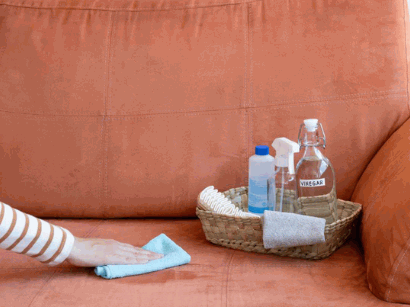Do you have a suede couch that’s in need of a good cleaning?
We will explore the world of suede upholstery, including what makes suede different from other fabrics and the various types of stains that can occur on suede couches.
Learn how to properly identify and clean different types of stains on suede, as well as the risks and alternatives to using a carpet cleaner on suede couches.
So, can you clean a suede couch with a carpet cleaner? Let’s find out!
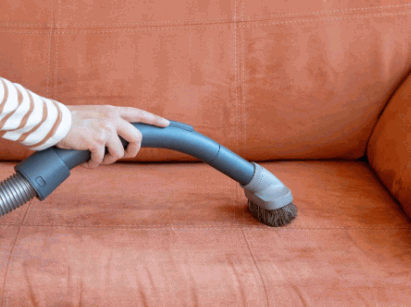
Can You Clean A Suede Couch With A Carpet Cleaner?
Cleaning a suede sofa with a carpet cleaner is a common question among homeowners seeking to maintain the freshness and appearance of their furniture.
Suede upholstery requires special care due to its delicate nature and sensitivity to harsh cleaning agents. Using a carpet cleaner on suede could potentially result in discolouration or damage, as the formulas designed for carpets may be too strong for the delicate fibres of suede.
It’s essential to follow correct cleaning techniques such as gentle brushing with a suede brush or using specialised suede cleaning products. For a more thorough and effective cleaning, professional cleaning services tailored to suede upholstery can provide deep cleansing while preserving the fabric’s integrity and prolonging its lifespan.
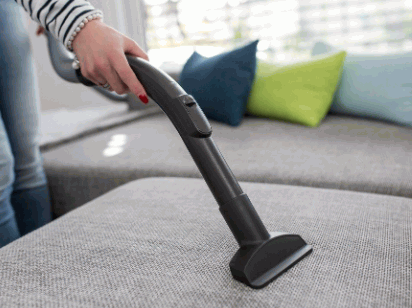
What Is Suede?
Suede is a type of soft, luxurious fabric commonly used in upholstery to enhance the elegance and comfort of furniture pieces.
Known for its velvety texture and rich appearance, suede is a popular choice for furniture upholstery due to its tactile appeal and ability to add a touch of sophistication to any room. Whether used in sofas, armchairs, or ottomans, suede provides a natural warmth and inviting feel to the furniture.
It is essential to note that suede requires proper care and maintenance to preserve its beauty and durability over time. Regular cleaning and protection against spills and stains are crucial steps in ensuring the longevity of suede furniture pieces.
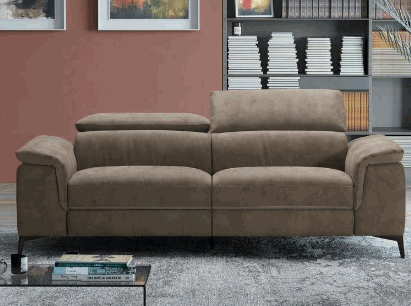
What Makes Suede Different From Other Fabrics?
Suede stands out from other fabrics due to its unique texture, delicate nature, and susceptibility to stains that require specialised cleaning techniques for effective removal.
One of the defining features of suede is its velvety softness, providing a luxurious and elegant touch to furniture pieces. Its distinctive matte finish sets it apart from glossy leather or smooth fabrics, adding a sophisticated flair to any room. While suede offers unparalleled comfort and style, its unique characteristics also make it more prone to staining compared to other materials.
Addressing stains on suede surfaces can be challenging, requiring gentle care to avoid damaging the fabric while effectively removing the blemish.
What Type Of Stains Can Occur On Suede Couches?
Suede sofas can be susceptible to a variety of stains, ranging from water-based stains to oil-based residues, requiring different methods of deep cleaning and spot treatments for effective removal.
Water-based stains such as coffee spills or juice marks can be dealt with using a mixture of mild soap and water and gently dabbed onto the affected area. For oil-based residues like grease or makeup, using cornflour or bicarbonate of soda to absorb the oil before gently brushing it off can be effective. Ink stains may need a specialised suede cleaner, while pet stains might require enzyme-based cleaners to break down the organic matter.
By understanding how to tackle each type of stain on suede sofas, you can keep your furniture looking clean and luxurious for years to come.
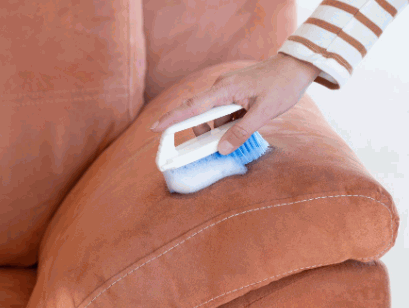
How To Identify Different Types Of Stains On Suede Couches?
Identifying different types of stains on suede sofas is crucial for selecting the appropriate cleaning solutions and conducting spot tests to ensure effective stain removal without damaging the fabric.
When it comes to recognising stains on suede upholstery, it’s important to observe the colour, texture, and origin of the blemish. Common types of stains include water-based stains like coffee or wine, oil-based stains from food or cosmetics, and ink stains.
To avoid causing further damage, always start by spot-testing any cleaning solution on a hidden area of the sofa. This simple step can help determine if the cleaner is safe to use on the entire stain without risking discolouration or worsening the damage. Carefully following these guidelines will ensure your suede sofa remains in top condition.
How To Clean Different Types Of Stains On Suede Couches?
Cleaning different types of stains on suede settees requires the use of appropriate cleaning products, specialised upholstery cleaners, and targeted stain removal techniques to rejuvenate the fabric effectively.
- For liquid stains like coffee or wine, start by blotting the affected area with a clean cloth to absorb excess liquid. Then, mix a small amount of mild detergent with water to create a gentle cleaning solution. Using a soft-bristled brush, gently scrub the stained area in a circular motion. Allow it to air dry.
- For oil-based stains, sprinkle cornstarch or baking soda on the affected area to absorb the oil. Let it sit for a few hours before brushing it off and using a suede brush to restore the nap of the fabric.
Water-Based Stains
Water-based stains on suede sofas can be effectively treated with mild water-based cleaners and dabbing techniques to freshen up the fabric without causing damage or discoloration.
- When dealing with water-based stains on suede furnishings, it’s crucial to act promptly to prevent the stain from setting deeper into the fabric. Begin by gently dabbing the affected area with a clean, white cloth to absorb as much of the liquid as possible. Avoid rubbing or scrubbing, as this can spread the stain further.
- Next, choose a water-based cleaner specially formulated for suede materials, following the manufacturer’s instructions for application. By delicately dabbing the cleaner onto the stain and allowing it to penetrate before dabbing again, you can effectively lift and remove the blemish without harming the suede’s texture or color.

Ink Stains
Ink stains on suede settees can be treated with gentle cleaning using a suede brush and specialised solutions to restore the fabric’s appearance and prevent ink penetration into the fibres.
When dealing with ink stains on suede upholstery, it is crucial to act promptly to avoid permanent damage. Begin by blotting the stain with a clean cloth to absorb as much ink as possible. Avoid rubbing the stain, as this can spread the ink further into the suede fibres. Then, use a suede brush to gently lift any remaining ink particles from the surface. For tough stains, consider using a specialised suede cleaner recommended for delicate fabrics. Regular maintenance and timely treatment of ink stains can help prolong the life of your suede furniture.
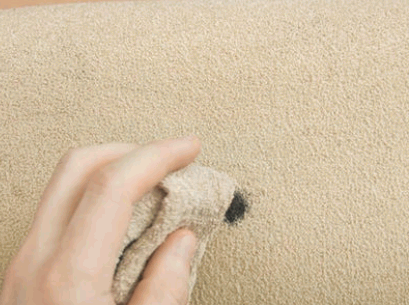
Mold Or Mildew Stains
Mould or mildew stains on suede settees should be addressed promptly through dry cleaning methods and odour elimination techniques to prevent further growth and maintain a fresh and hygienic environment.
If left untreated, mould and mildew stains on suede upholstery can not only compromise the aesthetic appeal of your furniture but also pose potential health risks. Mould exposure can trigger allergic reactions, respiratory issues, and other health concerns, making it essential to take proactive measures in cleaning and removing these stains.
Dry cleaning approaches, such as using a vacuum with a brush attachment or a suede brush, can effectively remove surface mould and mildew. In addition, incorporating odour elimination strategies, like using baking soda or specialised upholstery cleaners, can help combat any musty smells that may linger.
It is crucial to thoroughly clean suede upholstery regularly to prevent mould and mildew growth and ensure a healthy living space for you and your family.

Pet Stains
Pet stains on suede settees require effective household tips and spot-cleaning techniques to address the residues promptly and prevent lasting odours or discolouration on the fabric.
It is crucial to tackle these stains as soon as they occur to avoid them setting deeper into the suede. A quick solution involves gently blotting the affected area with a clean cloth or kitchen roll to mop up as much of the liquid as possible. Avoid rubbing the stain, as this can push it further into the fabric. For tougher stains, a mixture of mild soap and warm water can be gently applied using a soft-bristled brush to lift the residue without damaging the suede material.
Can You Use A Carpet Cleaner On Suede Couches?
Using a carpet cleaner on suede settees poses potential risks and challenges that necessitate cautious consideration and the application of household tips for safe and effective cleaning.
Suede upholstery requires gentle cleaning methods to avoid damage due to its delicate nature. When considering using a carpet cleaner, it is important to test a small, inconspicuous area first to ensure compatibility. Beware of using excessive water or harsh chemicals, as they can leave permanent stains or discolouration on suede surfaces. Instead, opt for specialised suede cleaning products or DIY solutions like a mixture of vinegar and water for mild stains. Regular maintenance, such as brushing with a soft-bristled brush, can also help preserve the suede’s texture and appearance.

What Are The Risks Of Using A Carpet Cleaner On Suede Couches?
The risks of using a carpet cleaner on suede settees include potential fabric damage, colour alteration, and ineffective cleaning outcomes, emphasising the importance of seeking professional advice and following a meticulous cleaning process.
Suede upholstery requires specialised care due to its delicate nature, making it vulnerable to harsh chemical cleaners commonly found in carpet cleaning products. These cleaners may strip the fabric of its natural oils, leading to a loss of softness and texture, ultimately diminishing the aesthetic appeal of the furniture.
To prevent such negative consequences, it is imperative to consult experts in suede cleaning who can recommend suitable products and techniques tailored to maintaining the integrity of the material. By adhering to a systematic cleaning routine involving gentle brushing, vacuuming, and occasional spot treatment with mild solutions, you can effectively preserve the quality and lifespan of your suede upholstery.
How To Properly Use A Carpet Cleaner On Suede Couches?
Properly using a carpet cleaner on suede settees involves selecting eco-friendly cleaners, employing gentle cleaning techniques, and following manufacturer guidelines to ensure effective and safe cleaning without compromising the fabric’s integrity.
To start, it’s crucial to test any cleaning solution on an inconspicuous area of the suede upholstery to check for colourfastness and any adverse reactions. Once confirmed, apply a small amount of the eco-friendly cleaner on a soft cloth or sponge and gently blot the stained or soiled areas, avoiding excessive rubbing or scrubbing which can damage the delicate fabric. Remember to always work in gentle, circular motions, and allow the fabric to air dry completely before using the settee again to prevent any potential water stains.
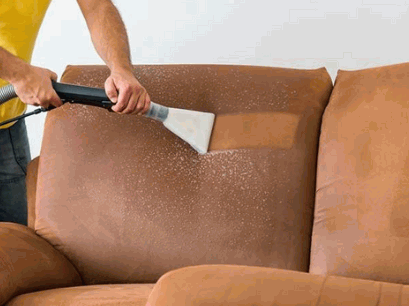
What Are The Alternatives To Using A Carpet Cleaner On Suede Couches?
Exploring alternatives to carpet cleaners for suede sofas reveals effective options such as dry cleaning, steam cleaning, and homemade solutions that offer tailored cleaning approaches and gentle care for the fabric.
- Dry cleaning is a professional method that uses specialised solvents to remove stains and dirt from suede upholstery without using excessive water, which can damage the fabric. It is highly effective in lifting stubborn stains and preserving the texture and colour of the suede.
- On the other hand, steam cleaning involves using steam to penetrate deep into the fabric, loosening dirt and stains for easy removal. DIY solutions, such as using a mild detergent solution and a soft-bristled brush, can be a cost-effective option for regular maintenance of suede sofas.
Regular vacuuming and blotting spills immediately help prevent dirt build-up and stains, prolonging the lifespan of the suede upholstery.
Dig deeper: How To Clean Outdoor Carpet On Patio
Dry Cleaning
Dry cleaning suede settees involve the use of absorbent powders and specialised cleaning supplies to remove dirt and rejuvenate the fabric without excessive moisture or damage.
One effective method for maintaining suede upholstery is to sprinkle an absorbent powder, such as cornflour or bicarbonate of soda, over the surface to draw out oil and grime. Let the powder sit for about an hour to absorb the dirt particles embedded in the fabric.
Next, gently brush off the powder using a soft-bristled brush or vacuum it off with a brush attachment. For deeper cleaning, consider using a specialised suede cleaner specifically formulated to treat delicate suede material.
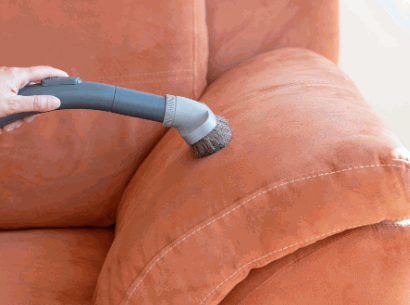
Steam Cleaning
Steam cleaning suede couches involves the use of steam and brushes to remove dirt, dust, and stains, providing a deep cleaning method that freshens up the fabric and protects its integrity.
To effectively steam clean suede upholstery, it is crucial to opt for a soft-bristled brush or vacuum attachment to gently remove any surface dust before starting the steaming process. The steam cleaner should be equipped with the appropriate attachment for delicate fabrics to ensure the suede is not damaged during cleaning. When using the steam cleaner, move it in a consistent and controlled manner over the fabric, allowing the steam to penetrate and lift away grime without saturating the material. This method not only helps in removing dirt efficiently but also aids in treating tough stains effectively, leaving your suede couch looking refreshed and revitalised.

Homemade Solutions
Homemade solutions for cleaning suede settees can be crafted using everyday household items, such as microfiber cloths and gentle cleaning tools, offering cost-effective and efficient methods for maintaining the fabric’s cleanliness.
These DIY cleaning approaches not only help keep your suede upholstery looking fresh and plush but also extend the lifespan of your furniture. When tackling stains or spills, it’s crucial to act quickly to prevent them from setting into the fabric. By gently blotting the affected area with a microfiber cloth and then following up with a homemade cleaning solution, you can effectively remove dirt and grime without damaging the delicate suede material.
